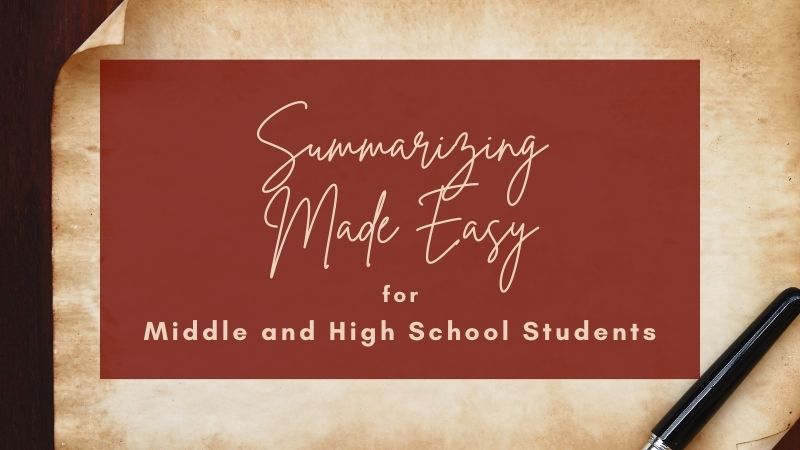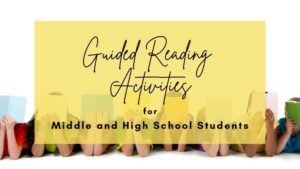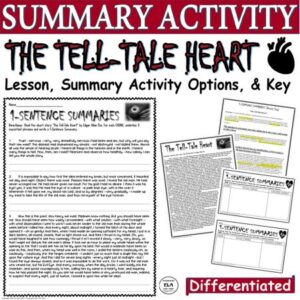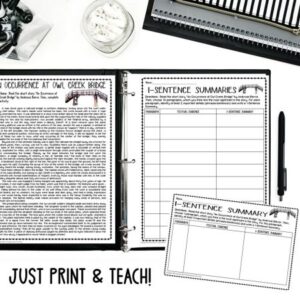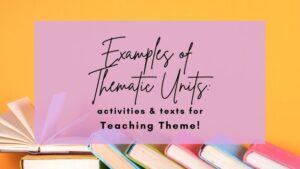Long story, short… that’s exactly what a summary is! But how often does someone who uses that statement actually make their story short?! Whether in school or in life beyond the classroom, summarizing is a skill that needs practice, repeated practice. Writing a summary is a skill that needs to be honed. It should be taught yearly, not just as a refresher but as though it’s a brand new task. Certainly, students will have a background in the skill as they have repeated exposure through worksheets on summarizing, but treating it as new means you can shift to more challenging texts and more challenging strategies for summarizing too!
If you’re just starting with summary skills, then consider this series of reading comprehension passages. Each of these worksheets on summarizing focuses on finding the central idea in either an informational or narrative text. Being able to find a central idea is a foundational skill, particularly if summarizing a short story.
Building on that skill in the initial stages will ensure students in classes all the way through AP Lang are able to be even more succinct with their summaries. To practice that, you could use this lesson that focuses on writing one-sentence summaries of a speech about child labor. These worksheets on summaries are ideal because the text is already in chunks to help differentiate for your students!
Need help with Test Prep? Check out this FREE Pack of 3 Test Prep Activities to help students achieve success on standardized tests!

Significance of Worksheets on Summarizing
As a skill, summarizing is integral to the development of critical thinking. With strategies for summarizing, students can sort important information from irrelevant information. And, with well-scaffolded worksheets on summarizing, students can analyze a variety of texts. They can then integrate this new information with their own background knowledge. In turn, this can better inform their thinking on a variety of topics from short stories to world issues featured in the news.
Summarizing is also relevant in life beyond the classroom. When applying for jobs, students will be asked to summarize their experience, so they’ll need to review their whole work history in order to pick out the most relevant and important information. If it’s in a job interview, this will need to be done quickly and effectively. A solid background in summarizing throughout high school means that this skill is finely honed and ready to be used at the minute!
Want help with guided reading activities you can use with worksheets on summarizing? Click below!
Difference between paraphrasing and worksheets on summarizing
Paraphrasing means rewording what someone else has written or said using your own words, usually to the same level of detail. In contrast, summarizing highlights the central idea without the inclusion of a lot of detail unless it supports the main idea.
Take a look at these examples using the opening paragraph of Poe’s “The Tell-Tale Heart”:
“True! — nervous — very, very dreadfully nervous I had been and am; but why will you say that I am mad? The disease had sharpened my senses — not destroyed — not dulled them. Above all was the sense of hearing acute. I heard all things in the heaven and in the earth. I heard many things in hell. How, then, am I mad? Hearken! and observe how healthily — how calmly I can tell you the whole story.”
Paraphrased: I was very anxious but I was not mad. In fact, my five senses were sharp, especially my hearing. I could hear everything both figurative and literal. But listen, I have a story to tell you and I will do it calmly and thoroughly.
Summarized: The speaker is anxious but has a story to tell.
In each instance, the paragraph is explained but note the difference in the level of detail. The paraphrase takes the seven sentences and re-tells the story in only slightly fewer sentences. The strategy for summarizing meanwhile is to boil down as much as possible to get to the central idea or, dare I say, the heart of the paragraph!
Get the worksheets on summarizing “The Tell-Tale Heart” by clicking below!
What You Can Summarize…
Any number of texts can be used for summary practice. Each one has value and can meet the requirements of different groups of learners in your English classroom.
- An entire text – This one is the most difficult! This type of summary can be pretty general as it needs to connect to each part of the text; it is broad in nature but still short in word count. It should be reserved for higher-level learners who have already found success with the types below.
- A chunk – As the saying goes, how do you eat an elephant? One bite at a time. The same is true for summarizing a text. Rather than focusing on a full text, shift to chunking into smaller pieces such as a paragraph or a few paragraphs combined. This is a tried-and-true method to differentiate. Check out these worksheets on summarizing “The Tell-Tale Heart” by Edgar Allan Poe that is already chunked for you and your students.
- Paragraphs/stanzas – Whether it is narrative, nonfiction, or even poetry, these smaller parts of texts make it a cinch for students’ summary practice. This poetry-focused activity incorporates SEL and strategies for summarizing by having students summarize stanzas into a single sentence.
- An excerpt – Another option is an excerpt from a larger work. In this way, students gain an idea of the whole of the text and make use of their inference skills as well. Another great way to feature excerpts is in specific pairings of fiction or nonfiction and poetry. This lesson that pairs an excerpt from Tolstoy’s Childhood with Robert Louis Stevenson’s poem “The Land of Story-books“ is an excellent example of joining two complementary texts using worksheets on summarizing independently in order to make thematic connections.
Need worksheets on summarizing for “An Occurrence at Owl Creek Bridge?” Click HERE!
Click HERE for help with teaching using thematic units!
Two Ways to Summarize
Paragraph Summary – For this type of summary a strong structure is key. Like a body paragraph that has its parts, so too does a paragraph summary. Explain to students that one sentence provides the central idea, another two to three sentences – this is flexible depending on the length of the text – provide details from throughout the text, and the last sentence reinforces the most important idea(s).
1-Sentence Summary – This method is by far my favorite! This is exactly what it sounds like in that the summary should only be ONE sentence in length. The best part of this option is its flexibility, so you can differentiate for your students. One group can summarize several chunks, whereas another group of struggling readers could summarize a single chunk. This set of differentiated graphic organizers for one-sentence summaries will make life easier for busy teachers looking to include more summarizing in class!
You can even make worksheets on summarizing more of a challenge with a layer of financial literacy by providing a value to each word and then a budget for the sentence. For example, each word is worth 10 cents and you have $1.20 to spend for the sentence. This is a way to keep things fresh too as you continue to work on one-sentence summaries throughout the course and year after year!
Why incorporate worksheets on summarizing?
No matter what type or length of text you use, practicing summarizing time and again is key! You want students to be able to pick out a central idea with comfort even if the text isn’t always easy. The higher the level of the text becomes, the more students need to practice summarizing. Using a variety of worksheets on summarizing that incorporate different strategies can make this easier for teachers and students alike!
Need more fun lessons and activities that incorporate worksheets on summarizing? Check out my store Kristin Menke-Integrated ELA Test Prep!

